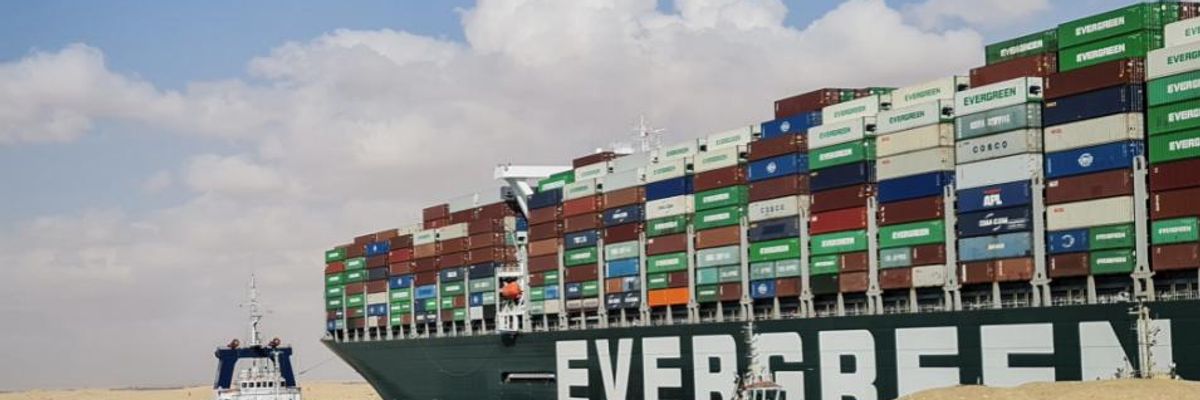It was immediately clear that the bulbous nose at the prow of the ship had lodged in the canal's bank, and the 1,300-foot body of the ship lay diagonally across the waterway, blocking traffic. Ironically, as my new book explains, the most dramatic leaps in ship sizes were precipitated by Suez Canal politics in the 1950s and 1960s. Decades later, it's the vast size of the ship that makes refloating it so difficult.
At a quarter-mile, the ship is almost as long as the Empire State Building is tall. When fully laden, Ever Given can carry 20,000 20-foot freight containers, stacked in 10 or 11 rows, both on the deck and in the ship's hold. Because of its size and its deep draft, only the largest ports with deep harbors and the largest gantry cranes can receive the ship.
That this vast flow of cargo could come to a halt because a gust of wind blew a ship off course makes the simultaneous immensity and brittleness of global trade apparent.
Since its inauguration in 1869, the Suez Canal has been one of the most significant arteries of global trade. Its construction by rival European powers--Britain and France--consolidated their empires in Asia and Africa. When Egypt nationalized the canal in 1956, Britain, France, and Israel attacked the country through Sinai. In the war that ensued, the canal was closed, filled with war debris and sunken ships.
The eight-month closure of the canal in 1956 and the eight-year closure after the 1967 war led to significant changes in global shipping. Here's why: If oil tankers from the Middle East now had to round the Cape of Good Hope to reach Europe, their journey would take at least three weeks longer.
To ensure profitability of this longer route, many freight carriers opted to take advantage of economies of scale by ordering massive new ships. In the space of a few years, oil tankers mushroomed in size, with the ultra large crude carriers reaching 1,300 feet, the same length as Ever Given.
Container ships account for much of global trade
About 30% of the world's seaborne trade today is in oil and petroleum products. Container ships like Ever Given primarily carry manufactured goods, and now account for one-third of the volume of global trade and an astonishing 60% of seaborne trade by value.
Nearly 12% of the world's cargo travels through the Suez Canal. That this vast flow of cargo could come to a halt because a gust of wind blew a ship off course makes the simultaneous immensity and brittleness of global trade apparent.
And the grounding of Ever Given also has exposed how the complex ownership structures in global shipping might make it difficult to hold anyone accountable. The Ever Given is operated by Taiwan-based shipping company Evergreen Maritime. Evergreen charters the ship from a Japanese firm; a Dubai-based company acts as the agent for the ship in ports; and the ship flies the flag of Panama.
Who might foot the bill?
A ship follows the laws of the flag it flies, not that of the ship's owners or operators. The Panamanian flag is a "flag of convenience." Flags of convenience, or open registries, have more lax labor and environmental regulations, and lower thresholds for safety and insurance provisions.
The grounding of Ever Given also has exposed how the complex ownership structures in global shipping might make it difficult to hold anyone accountable.
Last summer, the Wakashio, another ship owned by a Japanese firm but flagged to Panama, ran aground in Mauritius, spilling oil into the island's sensitive marine ecosystem. The fracturing of ownership and operation across different legal jurisdictions and national boundaries also makes it much harder to assign responsibility for accidents such as the grounding of Wakashio and Ever Given.
It is as yet unclear how long it will take for the Ever Given to be towed out of the flow of the canal traffic. As the clock ticks, Egypt is not collecting tolls on ships' passage. And ships, including those operated by Evergreen, have begun to reroute around the Cape of Good Hope.
For now, the knock-on effect of the stoppage is the accumulation of insurance claims and late fees, and delays in the delivery of cargo. But in the longer term, much as it did in the mid-20th century, the 2021 blockage of the Suez Canal, combined with the effects of the pandemic, may precipitate a reckoning in how maritime transport operates.

